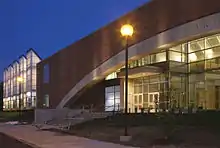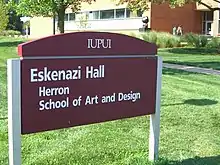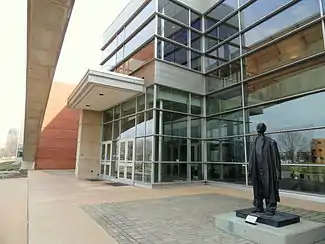Herron School of Art and Design
Herron School of Art and Design, a school of Indiana University, was ranked 59th overall by U.S. News and World Report among graduate schools of fine arts in 2016.[1]
 Sidney and Lois Eskenazi Hall, the new Herron building | |
| Type | Public, Coed |
|---|---|
| Established | 1902 |
Parent institution | Indiana University |
| Dean | Greg Hull |
Academic staff | 50 |
| Students | 800 |
| Location | 39.771265°N 86.17148°W |
| Website | herron |
Located on the campus of Indiana University–Purdue University Indianapolis (IUPUI), Herron enrolls nearly 800 students in bachelor's and master's degree programs including fine arts, visual communication design, art education, art therapy, and art history. Herron is also home to five galleries, which exhibit contemporary works of art by national and international contemporary artists and designers, as well the work of Herron faculty, alumni, and students; and the Basile Center for Art, Design and Public Life, which enriches educational and interdisciplinary activities through civic engagement and community partnerships.
Degrees offered
- Art History
Bachelor of Art Education
Bachelor of Fine Arts
- Ceramics
- Furniture Design
- Drawing and Illustration
- Integrative Studio Practices
- Painting
- Photography
- Printmaking
- Sculpture
- Visual Communication Design[2]
Master of Art Therapy
Master of Fine Arts
- Visual Communication Design
- Visual Art
Minors & Certificates
Notable alumni
- Wayman Elbridge Adams
- Simon Baus[9]
- Andrew Blauvelt
- Norman Bridwell
- Beulah H. Brown
- Francis Focer Brown
- Carol Ann Carter
- Vija Celmins
- Jay Hall Connaway
- Rob Day[10]
- Casey Eskridge
- James Wille Faust
- William Forsyth
- Ray H. French
- Marie Goth[11]
- Carl C. Graf[12]
- Don Gummer
- John Wesley Hardrick
- Robert Hess
- Felrath Hines
- Wilbert L. Holloway
- Robert Indiana[13]
- Bill Justice
- Misch Kohn[14]
- Terence Main
- Rinaldo Paluzzi
- Bill Peet
- Florence Smithburn[15]
- Kenneth E. Tyler
- Samuel E Vázquez
- Robert Edward Weaver[16]
- Cornett Wood
- Hale Woodruff
- Louise Zaring[15]
Timeline
- 1800s
The Art Association of Indianapolis, formerly the Indiana School of Art, was established in 1883. In 1895, John Herron bequeathed most of his fortune (almost $250,000) to the Association, which was headed by suffragette May Wright Sewall. Herron stipulated that the money be used to build a museum and art school in his name. (Based on inflation, $250,000 in 1895 would be equivalent to $7,002,734 in 2014).
- 1900s
Due to Herron's gift, the John Herron Art Institute was formed in 1902 in Indianapolis to serve as an art museum and an art school. The Institute's Herron Museum, an Italian Renaissance Reviva-style building, was designed by Vonnegut and Bohn architects and located at 1701 North Pennsylvania Street in the present-day Morton Place. The Institute's main building was designed by Paul Philippe Cret in 1929, and was the second facility in the nation designed specifically for art education.
The first core faculty included Indiana Impressionist painters of the Hoosier Group: T.C. Steele, J. Ottis Adams, William Forsyth, Richard Gruelle, and Otto Stark. The sculptor Rudolph Schwarz was also in the first core faculty.

- 1960s
Fesler Hall (1962), a major addition to the former John Herron Art Institute site along North Pennsylvania was Indianapolis architect Evans Woollen III's first civic commission. The three-story academic building was a freestanding wing addition that connected via covered walkway to the original, Cret-designed main building. Both of these structures are still standing. Woollen's addition was noted for its use of reinforced concrete and exposed columns, which are typical of Brutalist architecture, and its deeply coffered ceilings.[17] The project was funded through a bequest of Caroline Marmon Fesler, a former board member and president of the Indianapolis Art Association (which became the Indianapolis Museum of Art in 1969).[18]
In 1967, the Herron School of Art became a school of Indiana University. Two years later, it became part of IUPUI—Indiana University-Purdue University Indianapolis, located near downtown Indianapolis. In 1970, the Indianapolis Museum of Art separated from the school, taking with it a majority of Herron's art collection.

- 2000s
The Herron School of Art and Design launched a capital campaign to raise funds for new buildings in 1999, and in 2000 a ceramic arts facility was opened.
In 2003 The Herron Chronicle was published detailing the past 100 years of the school's history.
In 2005, Eskenazi Hall, the current home of the school, was completed.[19] This 169,000-square-foot (15,700 m2) facility tripled the amount of space available to Herron students and includes a 5,500-square-foot (510 m2) library, a 240-seat auditorium, 4,200 square feet (390 m2) of gallery space, and several computer labs.
The original Herron art school's buildings now house Herron High School, a classical liberal arts charter high school. They are within the Herron-Morton Place Historic District.
Benefactors
Caroline Marmon Fesler: The daughter of local industrialist and automobile manufacturer Daniel W. Marmon (Ray Harroun drove a Marmon car to victory in the first Indianapolis 500 race in 1911), she studied painting in Europe. Later, she became a well-known art collector, especially of 20th-century modernist works, many of which she later gave to the Herron Museum—including Grey Hills by her friend, Georgia O'Keeffe. Along with Sullivan, Fesler propelled the Herron Museum into the era of modern art.
Herman C. Krannert: Founder and president of Inland Container Corporation, Krannert agreed to take charge of the Art Association in 1960, at a point when the organization was struggling to stay afloat. Krannert insisted the group reorganize its board and its way of doing business, including creating the position of board chairman—he became the first person to have that title and he held it for 12 years. His tenure culminated in the relocation of the Museum from the Herron campus at 16th and Pennsylvania streets to its current 38th St. and Michigan Road site, and the Art Association's name changed to the Indianapolis Museum of Art.
References
- "Rankings: Fine Arts". U.S. News and World Report. Archived from the original on 2009-05-04. Retrieved 2018-02-20.
- Visual communication
- "Minor in Art History: Minors & Certificates: Academics: Herron School of Art + Design: Indiana University–Purdue University Indianapolis". Herron School of Art + Design. Retrieved 6 September 2018.
- "Minor in Book Arts: Minors & Certificates: Academics: Herron School of Art + Design: Indiana University–Purdue University Indianapolis". Herron School of Art + Design. Retrieved 6 September 2018.
- "Minor in Design Production: Minors & Certificates: Academics: Herron School of Art + Design: Indiana University–Purdue University Indianapolis". Herron School of Art + Design. Retrieved 6 September 2018.
- "Graduate Certificate in Design Thinking". Herron School of Art + Design. Retrieved 6 September 2018.
- "Certificate in Pre-Art Therapy: Minors & Certificates: Academics: Herron School of Art + Design: Indiana University–Purdue University Indianapolis". Herron School of Art + Design. Retrieved 6 September 2018.
- "Minor in Studio Art and Technology: Minors & Certificates: Academics: Herron School of Art + Design: Indiana University–Purdue University Indianapolis". Herron School of Art + Design. Retrieved 6 September 2018.
- "Simon (Paul) Baus". Fine Estate Art. Retrieved 20 July 2015.
- "Rob Day". Rob Day. Archived from the original on 9 September 2015. Retrieved 20 July 2015.
- "Portrait of Theodore Clement Steele". Indianapolis Museum of Art. Retrieved 20 July 2015.
- "Carl C. Graf". Fine Estate Art. Retrieved 20 July 2015.
- "Robert Indiana". RoGallery. Retrieved 20 July 2015.
- Squatriglia, Chuck (February 17, 2003). "MISCH KOHN / Modern artist – acclaimed printmaker". SF Gate. Hearst Newspapers. Retrieved 20 July 2015.
- Judith Vale Newton and Carol Ann Weiss (2004). Skirting the Issue: Stories of Indiana's Historical Women Artists. Indiana Historical Society Press. ISBN 0-87195-177-0.
- Schiller, JK. "November 15". The Rockwell Center for American Visual Studies. Retrieved 20 July 2015.
- Kevin A. Drawbaugh (16 February 1988). "Woollen's Mark Seen on Major Indiana Buildings". Indianapolis News. Indianapolis: C3. See: "Biographical" Sketch in Woollen, Molzan and Partners, Inc. Architectural Records, ca. 1912–2011. Indianapolis: Indiana Historical Society. 2017. See also: Mary Ellen Gadski, "Woollen, Molzan and Partners" in David J. Bodenhamer and Robert G. Barrows, eds. (1994). The Encyclopedia of Indianapolis. Bloomington and Indianapolis: Indiana University Press. p. 14. ISBN 0-253-31222-1.CS1 maint: extra text: authors list (link) See also: "Young Architects in the United States: 1963". Zodiac. Milan, Italy. 13: 168.
- "Newfields: History". Newfields (Indianapolis Museum of Art). Retrieved December 18, 2017.
- "Herron History". IUPUI. Archived from the original on 2011-12-14. Retrieved 2011-12-21.